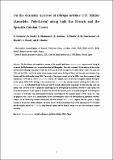Por favor, use este identificador para citar o enlazar a este item:
http://hdl.handle.net/10261/39432COMPARTIR / EXPORTAR:
 SHARE
BASE SHARE
BASE
|
|
| Visualizar otros formatos: MARC | Dublin Core | RDF | ORE | MODS | METS | DIDL | DATACITE | |

| Título: | On the dramatic increase of Ditrupa arietina O.F. Muller (Annelida: Polychaeta) along both the French and the Spanish Catalan coasts |
Autor: | Grémare, Antoine; Sardá, Rafael CSIC ORCID ; Medernach, L.; Jordana, E. CSIC ORCID ; Pinedo, Susana CSIC ORCID ; Amouroux, J. M.; Martin, Daniel CSIC ORCID CVN ; Nozais, Christian; Charles, F. | Palabras clave: | Gulf of Lions Ditrupa arietina Serpulid Polychaete Spatial distribution |
Fecha de publicación: | 1998 | Editor: | Elsevier | Citación: | Estuarine, coastal and shelf sciences 47 : 447-457 (1998) | Resumen: | The distribution and population structure of the serpulid polychaete Ditrupa arietina were assessed along the section of the Mediterranean coast between Barcelona and Montpellier. The study combined: (1) the analysis of the existing historical data referring to the period before the 1970s; (2) the results of impact assessment surveys carried out in the late 1980s and the 1990s; and (3) the results of two surveys carried out in the Bay of Blanes and along the coast between Cape Cerbe`re and Port-la-Nouvelle during 1996. The results of the surveys carried out in the 1990s show the occurrence of high densities (i.e. >1000 ind m"2) of Ditrupa arietina at all the sites sampled. These results can be compared with the few reports of this species before 1970, leading to the conclusion that D. arietina has recently increased all along the Catalan coast. Ditrupa arietina is preferentially found between 20 and 30 m depth, which mostly corresponds to well-sorted fine sands and muddy sands. Both the results of population monitoring and the heterogeneity of population structure at small spatial scale show that the dynamics of this species is unstable. The observed distribution pattern is therefore interpreted as resulting from a response to both wide-scale environmental parameters (accounting for the dramatic increase of the species at a wide geographical scale), and to local environmental factors (accounting for small-scale heterogeneity in population structure). Analysis of the relationship between sedimentary data and densities of D. arietina suggests that this species is highly sensitive to the presence of fine sediments. However, because of the regional importance of the phenomenon, it is concluded that the dramatic increase of D. arietina along both the Spanish and the French Catalan coast does not result from sediment instability. | Descripción: | 11 páginas, 5 figuras, 2 tablas. | URI: | http://hdl.handle.net/10261/39432 | ISSN: | 0272-7714 |
| Aparece en las colecciones: | (CEAB) Artículos |
Ficheros en este ítem:
| Fichero | Descripción | Tamaño | Formato | |
|---|---|---|---|---|
| Gremare et al.pdf | 543,39 kB | Adobe PDF |  Visualizar/Abrir |
CORE Recommender
Page view(s)
347
checked on 23-abr-2024
Download(s)
111
checked on 23-abr-2024
Google ScholarTM
Check
NOTA: Los ítems de Digital.CSIC están protegidos por copyright, con todos los derechos reservados, a menos que se indique lo contrario.
